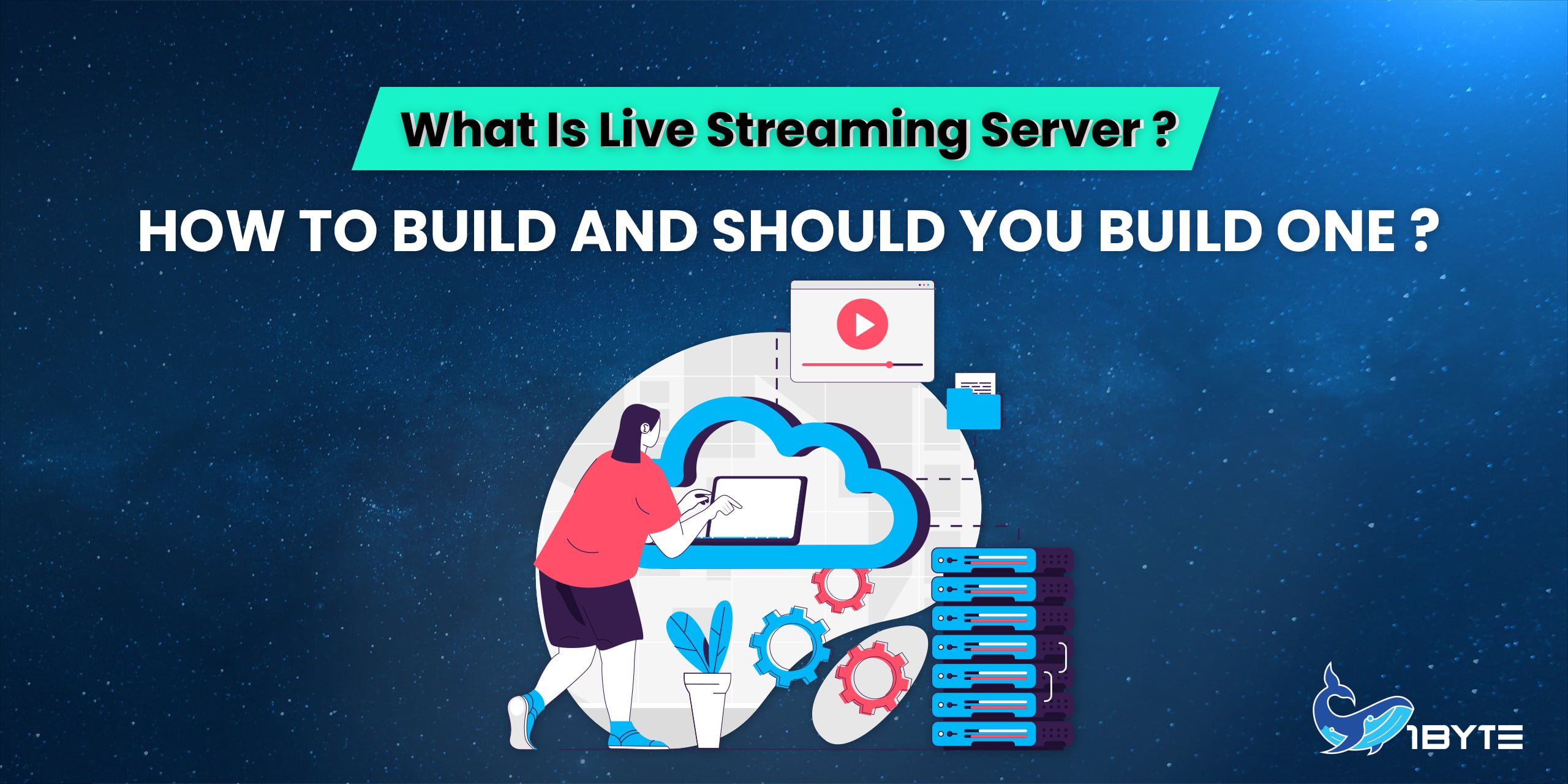Streaming is a simple way to broadcast live. And because you can do it on your own terms and in-house, it seems like a good approach. However, there are many risks involved with doing this yourself. A DIY approach can be very appealing because it gives you full control over your live stream and no one else can tell you what to do.
What Is a Video Streaming Server?

Video streaming is the process of sending a video over the internet as a stream of data. Unlike downloading the file and saving it to a hard disk, streaming doesn’t require users to do so. People can watch the video as it loads, rather than having to wait for the file to download first. Streaming also has the disadvantage of requiring a solid connection for smooth playback with low latency.
To help users share large files over a data connection, a video file first needs to be encoded into small file packages. It is then sent to the client and decoded again into a viewable video on the user’s video player. This encoding and decoding are done by so-called codec software.
The Target Audience of Video Streaming Server

Streaming content is gaining popularity. Streaming servers are serving this content to your audience. These servers are essential. You need them to communicate with your audience effectively. They’re the backbone of any live or on-demand video stream. This is especially true for mobile devices because they sacrifice quality for speed.
That means that streamers have three options:
- Deliver your stream via free online video platforms such as Twitch, Youtube, and Facebook.
- Use paid online video platforms, like Kaltura, which have the added power and reliability of a professional server.
- Build your own server and DIY the stream from ingestion to last-mile delivery.
FURTHER READING: |
1. How to Host Multiple Websites on a Single Server (Apache & NGINX) |
2. Best Cheap Dedicated Server in Asia |
What’s Great About Video Streaming Server?
Video streaming is an important part of our lives now. The infrastructure that makes it possible is complex and requires a specialized server. When you’re looking for a video streaming service, it makes sense to keep ownership of the entire process. We’ll break this down into its basic components.
Powerful Streaming With Robust CPU
An integral component of your chosen live-streaming solution is the video server. A CPU runs the software, which manages your content — from geo-restrictions to CDN. It’s this server that determines the resolution of your video feed.
Wondering how this can help your business? For instance, you have a well-designed video streaming application to help your client’s customers stream video content. However, there are times when the internet connection is not optimal. This can cause your client’s customers to have a bad experience. In these cases, it is important to have a solution in place that will adjust the video resolution accordingly and improve the user experience.
How Much RAM Is Needed For good streaming?
For good streaming, the RAM needed must be at least 16 GB. A large number of people think that 16 gigabytes are the largest size a video file can be. This is true to a certain extent. If you stream a video online, you are downloading the file to your computer and upload it again when you watch it. So, if you watch the same video multiple times at once, it will be uploaded to memory multiple times.
File Occupation Inside The Disk That Impacts On Server
When you’re building a video server, do you know how much space it will take up? Most businesses have a hard time estimating the size of their videos. Estimating the size of your videos is important, but so is making sure your video server has enough capacity to stream them.
We recommend starting with 1TB and then increasing it as you go along the way.
Port Size Of The Bandwidth Matters In Playability
It’s not easy to tell how much space you need for your videos and photos. You have to know how big your videos are and store them somewhere. The common practice is to stream videos from a server that has enough room.
In addition, there are different qualities of videos. That way, you can have multiple copies of your video made. Each copy has different resolution levels.
To improve your app’s performance, you should free up space on your disk. You should also use an SSD to store videos and cache your application. Finally, you should use a regular hard drive to store bulk data, which will reduce costs.
Why Do You Need A Video Streaming Server?
Servers are used to stream media content over the internet on devices such as computers, smartphones, or tablets. Hosting for streaming video is a powerful tool that can help content owners, aggregators, or media influencers deliver high-quality video content to viewers. What reasons exactly do you need a video streaming server?
Multiple Format Viewability
To stream videos, multiple video formats are required. This means that your website needs a new server. For video to work, the encoder will assist in creating a variety of formats, while the HLS video player delivers the final result.
Maintenance Is The Key
The backbone of your streaming infrastructure is maintenance. It is the key to a good video streaming service as it will prevent any errors from happening in your system. Therefore, it is important to maintain the system by avoiding any kind of issues that you might encounter.
Secure Path Delivered
It is important to have a secure streaming server because it will protect you from vulnerable attacks. For example, encryption with a 128-bit key or cryptography provides the utmost safety for your data and contentions against other providers who may try accessing them without permission.
Powered Compatibility
Compatibility is the reason why you need to invest in a video streaming server. Different types of networks necessitate different levels of compatibility. It’s essential to have additional support from major content delivery networks (some are CDNs) as another server component taking care of continued high-quality content streaming.
Strategized View Regions
When you have a video streaming server, you can create restricted viewing environments in a limited number of servers. The best cloud stream technology is harnessed when the servers dynamically scale and load-balance in a very short time period.
How to Build a Video Streaming Server?
When it comes to hosting for streaming video, it can be quite tricky to set up the server. Make sure you partner with competent and experienced developers. Here are 5 steps to set up a video streaming server:
1. Get Clean on Requirements
In order to build a successful live-streaming server, it is important that you know what features and capabilities are desired from your live-streaming server. Before getting started, you should ask yourself: What is the purpose of your stream? How big is your audience? What quality of the stream is most important to you? Do you have Windows, Ubuntu, or Mac OS? What are your system requirements?
These questions make things clear and you can know what you need to do next. For example, setting up your streaming server on Windows is implemented differently from the setting process on Linux.
2. Choose an Open-Source Project
The best way to build a video server is by finding an open-source project that supports your preferred video player and streaming protocols. The best solution is not to create your own code but to find a compatible open-source project that you can use as a base. Building a video server is not as difficult or time-consuming if you have access to an open-source library of code.
3. Download OBS Studio
Once you’re ready to stream, you can use OBS Studio. This free, open-source software is available for Windows and Mac users and allows for encoding and other streaming functions. To use it, you can run the Auto-Configuration Wizard to test your system and make adjustments to your settings.
4. Create a CDN
The first step to building CDN for video streaming, you must decide between cloud servers and physical servers. Physical servers are more reliable, but you may be better off with a cloud server if you lack the proper resources.
Next, you’ll have to place your original server and PoPs. It’s essential for your video streaming server to work that you build a reliable CDN network from scratch. Once you have, we recommend downloading Varnish, a CDN-building tool, for assistance in tying everything together.
5. Additional configurations
Your streaming solution is up and running, but it could use some more features. You might want to add security features and monetization. You should also have Adaptive Bitrate (ABR) which allows you to stream in the best quality possible. You might also need transcoding, low-failure equipment, high-end security, uninterruptible power supplies, and things like that. For cloud-based servers, Amazon AWS is an option but you should check how many views/downloads you’ll need to know whether it’s cost-effective or not.
Pros and Cons of a DIY Live Streaming Server
Latency
Latency is the time it takes for your live stream to reach your viewers. There are two factors that affect latency.
The first factor – distance- impacts video feeds primarily because data has been processed slower as you’ve moved away from our servers; this can make videos seem jumpy or laggy if they’re being sent over far distances via an internet connection alone.
Another important factor is how many people are watching at the same time. If there is too much traffic, or a lot of people are watching videos at once, it can cause lag in the video.
Buffering
The online video feed may be slow or buffering. The solution is to use multi-bitrate streaming and an adaptive player which is critical for smooth video viewing.
The best quality video is achieved through adaptive bitrate streaming (ABR), which is built into most online video platforms. However, if you are self-hosting your videos, you may not have access to this feature. Adaptive bitrate streaming automatically adjusts the video quality based on a viewer’s internet connection speed.
Lack of Redundancy
You should always have a backup stream even if you are using dynamic servers, such as live-streaming content delivery networks. If one machine goes offline or experiences an issue that cannot be fixed system-wide, your viewers will still receive their video feed from another server in the network and not suffer delays.
Limits to Scale
When you start broadcasting live, you might find that your audience is limited. The reason could be that each server can only handle a certain number of viewers at once. As your audience grows, you need to add more servers to accommodate more people. Adding new servers can be challenging due to the costs and complexity. You may end up paying even more money to solve issues of scale. If you take the professional approach, however, you will use their entire network of servers if your site goes viral and gets a lot of traffic.
Security Vulnerabilities
Running your own server is not without its risks. You are responsible for your own privacy and security, which means you’ll have to protect your server. At the same time, you’ll also have to deal with threats like hacking, piracy, and data breaches.
If you are not unsure about your security knowledge, you might need a trusted hosting for streaming video that is secure and reliable. When you stream through a professional platform, they’re taking care of all the security measures, which could be more substantial than your own small-scale security measures.
Technical Debt
The tech world has a concept called “technical debt.” This is the consequence of creating anything technological. Once you’ve created it, you have to maintain it. Even if you have your own system designed to solve a problem, the system may cause new problems. As a result, the best solution is to hire professionals who will take care of everything for you
No Tech Support
Your live stream is suffering from problems during a broadcast. When you build your own streaming servers, you don’t have the luxury of 24/7 customer support that end-to-end streaming solutions provide. So you will have to provide your own support.
Alternatives to Self-Hosting
One great alternative to building your own server and streaming platform is using a video streaming hosting provider. Most companies offer SaaS (Software as Service) hardware with IaaS (Infrastructure As A Services). This means that by paying monthly fees for their services, they will provide access not only to world-class hardware but also to live broadcasting software which makes your task easier!
FAQs
What are the requirements needed for a best streaming server?
When you want to stream video online, you have to set up a secure streaming server. You can choose from many providers if you want exact components for your streaming business requirements. If you want to stream live video, you’ll need a dedicated server. If you want a platform that lets you stream videos on-demand, it’s easier to use an off-the-shelf platform.
Some of the most common video delivery protocols are Content Delivery Networks, adaptive bitrate protocols, and streaming protocols such as Apple Fairplay.
How much does a video stream server cost?
Setting up a live video stream is not a one-size-fits-all process. The cost of streaming is determined by a number of factors, but costs can vary depending on what type of streaming service you want to use and how many people you want to reach.
How do I set up a Media Streaming Server?
Building a streaming server can be difficult, so you’ll want to choose the best developer for the job. Here are the main steps in streaming server development: Prep the server by installing it, configure streaming software, build a CDN infrastructure, add streaming protocols, and much more.
Leverage 1Byte’s strong cloud computing expertise to boost your business in a big way
1Byte provides complete domain registration services that include dedicated support staff, educated customer care, reasonable costs, as well as a domain price search tool.
Elevate your online security with 1Byte's SSL Service. Unparalleled protection, seamless integration, and peace of mind for your digital journey.
No matter the cloud server package you pick, you can rely on 1Byte for dependability, privacy, security, and a stress-free experience that is essential for successful businesses.
Choosing us as your shared hosting provider allows you to get excellent value for your money while enjoying the same level of quality and functionality as more expensive options.
Through highly flexible programs, 1Byte's cutting-edge cloud hosting gives great solutions to small and medium-sized businesses faster, more securely, and at reduced costs.
Stay ahead of the competition with 1Byte's innovative WordPress hosting services. Our feature-rich plans and unmatched reliability ensure your website stands out and delivers an unforgettable user experience.
As an official AWS Partner, one of our primary responsibilities is to assist businesses in modernizing their operations and make the most of their journeys to the cloud with AWS.
Conclusion
Running your own video streaming server may seem like a good idea, but it takes a lot of time and effort to maintain. It is understandable why you want complete control over your video streaming process, but you’d be better off using a third-party service such as 1Byte – one of the top web hosting providers. 1Byte is not just a service provider, but a partner who will always collaborate hand-in-hand to build a strong data center infrastructure that will make your business successful.

